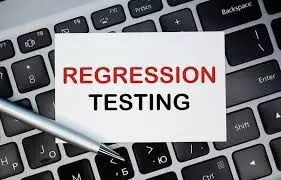Regression Testing: The Guardian of Software Quality
image for illustrative purpose

In the fast-paced world of software development, new features are constantly being added and existing functionalities are refined. While innovation is crucial, it's equally important to ensure that these changes don't break what already works. This is where regression testing comes in – acting as a vital safeguard for software quality and user experience.
Understanding Regression Testing
Regression testing is a systematic process of re-running previously executed tests on a software application after any code modifications. Its primary objective is to identify any unintended regressions or bugs introduced by the changes. Imagine it as a quality check to verify that existing functionalities haven't been compromised by the new additions.
Why is Regression Testing Important?
There are several compelling reasons why regression testing is an essential part of the software development lifecycle (SDLC):
● Prevents Regressions: New code can inadvertently introduce bugs that affect existing functionalities. Regression testing helps catch these issues early on, preventing them from reaching production and jeopardizing user experience.
● Maintains Confidence: By regularly performing regression testing, developers gain confidence in the stability of the codebase. This allows them to focus on building innovative features without worrying about breaking core functionalities.
● Reduces Costs: Fixing bugs in production is significantly more expensive than identifying and resolving them during the development phase. Regression testing helps prevent these costly post-release fixes.
● Ensures Quality: Regression testing contributes to overall software quality by verifying that the application functions as intended after changes. This enhances user satisfaction and brand reputation.
● Faster Time to Market: Efficient regression testing helps automate the testing process, leading to faster release cycles. This allows businesses to deliver new features and updates to users sooner.
Types of Regression Testing
There are various approaches to regression testing, each suited to different scenarios. Here's a breakdown of some common types:
● Full Regression Testing: This involves re-running all existing test cases after a significant code change. While thorough, it can be time-consuming for large codebases.
● Selective Regression Testing: This targets a subset of test cases considered most critical or likely to be impacted by the changes. It offers a balance between comprehensiveness and efficiency.
● Smoke Testing: A basic level of testing aimed at identifying critical functionality breakdowns after a minor code change. It helps validate overall system stability before further testing.
● Regression Test Automation: Leveraging automation tools to execute test cases significantly reduces testing time and effort. This is particularly beneficial for large-scale regression testing.
Challenges of Regression Testing
Despite its advantages, regression testing presents some challenges:
● Maintaining Test Suite: As the codebase evolves, the test suite needs to be regularly updated to reflect new functionalities and changes. This ongoing maintenance can be time-consuming.
● Test Case Selection: Deciding which test cases to include in a regression cycle requires careful consideration. A balance needs to be struck between comprehensiveness and efficiency.
● Automation Complexity: Setting up and maintaining automated regression testing frameworks can require initial investment and technical expertise. However, the long-term benefits outweigh these initial costs.
Best Practices for Effective Regression Testing
Here are some best practices to ensure successful regression testing:
● Prioritize Test Cases: Identify and prioritize critical test cases to ensure core functionalities are thoroughly tested.
● Leverage Automation: Utilize automation tools to streamline the testing process and reduce manual effort. Tools like Opkey can significantly improve efficiency and accuracy.
● Maintain Test Suite: Regularly update and maintain the test suite to reflect changes in the codebase.
● Continuous Integration (CI): Integrate regression testing into the CI pipeline for automatic execution after every code commit. This helps catch regressions early and often.
● Document Everything: Proper documentation of test cases and regression testing procedures ensures consistency and facilitates future maintenance.
Conclusion
Regression testing plays a critical role in safeguarding software quality and maintaining user trust. By understanding the types, benefits, challenges, and best practices associated with regression testing, developers can implement effective strategies to ensure smooth software evolution. Remember, investing in regression testing is not just about identifying bugs, it's about preventing regressions and ensuring a positive user experience in the long run.
Opkey: Your Automation Ally
While this blog focused on the broader aspects of regression testing, it's important to acknowledge the significant role automation plays in making this process efficient. Opkey, a leading provider of AI-powered test automation solutions, empowers developers to streamline regression testing. Opkey's intuitive platform reduces test creation time, prioritizes test cases based on potential impact, and facilitates self-healing scripts that adapt to changes. By leveraging Opkey, development teams can confidently implement regression testing practices and accelerate software delivery without compromising quality

